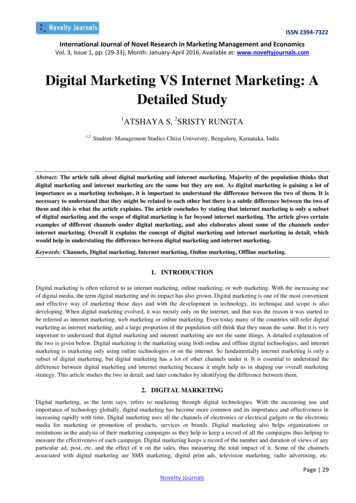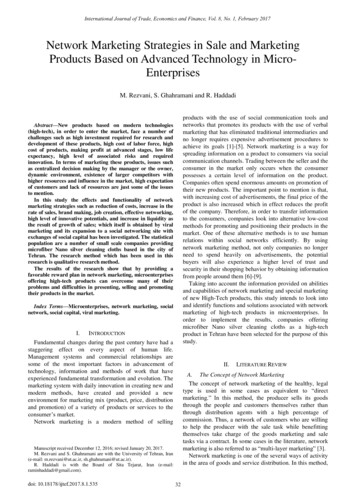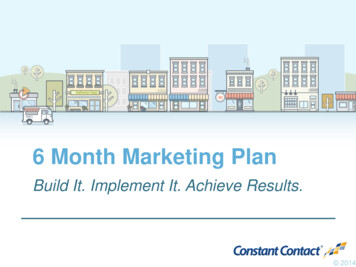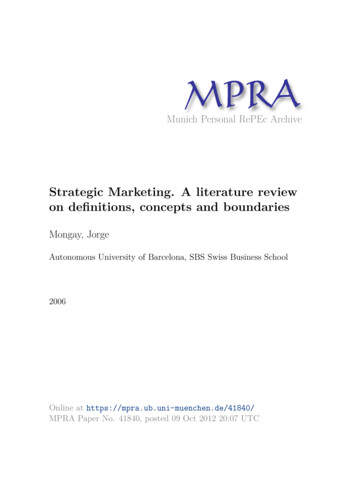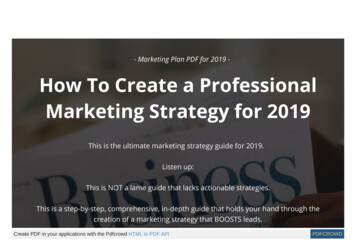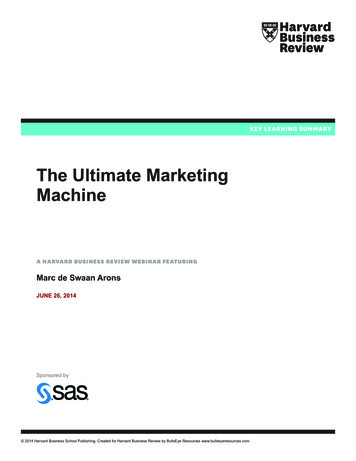
Transcription
FACULTY OF EDUCATION AND BUSINESS STUDIESDepartment of Business and Economics StudiesSmall enterprises’ marketing strategy in the digital eraA study of hotels in SwedenDaniel Tadesse & Tobias Pettersson2019Student thesis, Master degree (one year), 15 CreditsBusiness AdministrationMaster Programme in Business Administration (MBA): Business Management 60 CreditsMaster Thesis in Business Administration 15 CreditsSupervisor: Daniella FjellströmExaminer: Maria Fregidou-Malama
AbstractTitle: Small enterprises’ marketing strategy in the digital eraSubtitle: A study of hotels in SwedenLevel: Master Thesis in Business AdministrationAuthors: Daniel Tadesse and Tobias PetterssonSupervisor: Daniella FjellströmExaminer: Maria Fregidou MalamaDate: 2019 - JuneAim: The aim of this study is to explore small enterprises’ marketing strategy, and the digital toolsthat can improve their odds in the market against competitors and gain competitive advantage.Method: Qualitative study was conducted using primary and secondary data for this study, whereprimary data was collected through ten semi-structured interviews. An inductive approach wasused to complete this study. The sample taken were seven small hotels and ten respondents whoown and manage the hotels.Result & Conclusion: Findings of this study show that digital marketing tools demand fewerresources such as marketing expenses, number of employees, and make marketing activitiessimpler for the managers of small enterprises. As a result of digitalization, small enterprises areable to implement the marketing mix (4Ps), although their primary focus is price followed byproviding customized product/service that fits the customers’ needs to gain competitive advantage.Suggestion for future studies: We found in our study that one hotel did not use social media atall, and it would be interesting to know if there are more enterprises that do not use it as well.Therefore, in future studies, a larger sample would produce more data about the use of socialmedias by small enterprises. Additionally, this study was conducted in a developed country contextand further research would be beneficial to emerging-market countries if it is conducted in theircontext. Finally, a deeper investigation on marketing strategy between different sizes of micro andsmall enterprises can provide greater knowledge about how they operate.Contribution of the thesis: This study has contributed to small enterprises’ marketing strategy,which shows that they focus on customer preferences rather than what their competitors offer. Italso contributes to SMEs’ digital marketing where digitalizing an enterprise’s marketing activitiesdecreases costs and increases dynamic capabilities to gain and maintain competitive advantage.I
Moreover, this study provides new thoughts about the marketing mix for SMEs, which includesthat cost leadership strategy is mostly used, hence, making them the price followers. In otherwords, they set their prices based on their competitors.Keywords: Marketing Mix, Hotel Industry, Digitalization, Social Media Marketing, CustomerSatisfaction.II
AcknowledgmentIt is with joy and pride we now have the opportunity to present our study here. This study is aresult of hard job, good supervision, and accommodating respondents that all have contributed tomake this study possible.First of all, we want to express our thankfulness to our fantastic supervisor Daniella Fjellströmfor her support and guidance through our work. Furthermore, we also want to express ourgratitude to our examiner Maria Fregidou Malama for her ambitious work to stimulate anddevelop our paper during the semester.We will also like to thank all the respondents for their participation and willingness to share theirthoughts to this study. All of their knowledge and insights have been helpful for us to completethis study, which have an essential implication to this study.Finally, we would like to thank all our classmates and others that have helped us during thisperiod to accomplish this study.Best regards, Daniel Tadesse & Tobias PetterssonIII
Table of Contents1. Introduction . 11.1 Background . 11.2 Research gap . 21.3 The aim of the study . 41.3.1 Research questions . 41.4 Delimitation . 41.5 Disposition . 52. Literature review . 62.1 Small enterprises’ marketing strategy. 62.1.1 Sources of competitive advantage . 82.2 The role of Digitalization . 92.2.1 Social media marketing. 102.3 Marketing Mix . 112.4 Customer Satisfaction . 132.5 Theoretical framework model . 163. Methodology . 183.1 Business research . 183.2 Research philosophies: Ontology and Epistemology . 193.3 Research Approach . 203.3.1 Qualitative and quantitative approach . 203.3.2 Inductive approach . 223.4 Data Collection . 233.4.1 Secondary data . 233.4.2 Primary data . 233.5 Presentation and analysis of the data . 273.6 Validity and reliability . 283.7 The ethics aspects . 294. Empirical Part . 304.1 Importance of marketing to small enterprises . 304.1.1 Marketing background . 314.1.2 Marketing Mix . 324.2 Role of Digitalization . 35
4.2.1 Visibility . 364.2.2 Communication . 384.3 Competition vs Cooperation . 394.4 Customer satisfaction and retention . 404.4.1 Customer knowledge . 415. Analysis . 435.1 Characteristics of small enterprises . 435.2 Digitalization. 445.2.1 The influence of Social media . 455.3 Identifying the Competitors . 465.3.1 Sources of competitive advantage . 465.4 Marketing mix . 475.4.1 Price . 485.4.2 Place . 495.4.3 Promotion. 495.4.4 Product/Service . 505.5 Customer satisfaction and retention . 505.5.1 Customization . 516. Conclusion . 556.1 Fulfillment of purpose of the study. 556.2 Discussion of the research questions . 556.3 Theoretical implication . 576.4 Managerial implication . 586.5 Societal implication . 596.6 Critical reflection of this study . 606.7 Limitations and Suggestion for future research . 60Appendices . 62Appendix 1: Interview guide in Swedish . 62Appendix 2: Interview guide in English . 64References . 66
List of FiguresFigure 1 Theoretical model . 16Figure 2 Small enterprises marketing to gain competitive advantage . 52List of TablesTable 1 Selected sample description . 24Table 2 Respondents’ demography . 26Table 3 Summary of empirical findings . 42Table 4 Summary of data analysis . 54
1. IntroductionThis chapter presents the background of small enterprises, their marketing strategies and exploresthe role of digitalization in marketing their products/services. Furthermore, research gapsresearch aim, research questions and delimitations are discussed.1.1 BackgroundSmall to medium-sized enterprises (SMEs) are important for the European economies (Buhalis &Main, 1998; Antony, Kumar & Madu, 2005), and have a significant role in creating new jobs,growth in GDP, entrepreneurship and innovation (Karadag, 2015; Jasra, Hunjr, Rehman, Azam &Khan , 2011). SMEs are enterprises with under 250 employees and operate in small areas (Jasra etal., 2011). Moreover, SMEs are also one of the significant factors of socio-economic growth(Karadag, 2015), and play an essential role in the development of a nation (Kalique, Isa, Shaari,Abdul & Ageel, 2011; Jasra et al., 2011). For instance, more than 99% of the business enterprisesin the UK, 99,9 % in Turkey are SMEs (Antony et al., 2005; Karadag, 2015), and 99,9 % in Sweden(European Commission, 2018), which shows the importance of these organizations in the market.According to Jasra et al. (2011), SMEs can be divided into micro-enterprises, small enterprises,and medium enterprises. This study focuses only at micro and small enterprises, which arecompanies with less than 50 employees (Jasra et al., 2011), because there is a lack of research inthe area we are investigating.Literature shows that small enterprises’ marketing approach is different from larger enterprises(Carson & Cromie, 1989). Before we discuss the marketing strategies of small enterprises, thereare some characteristics they possess that needs to be discussed. Carson and Cromie (1989) statethat small enterprises have several features that make them what they are, including the owner isusually one person or a few people where the firm operates locally. Owner of a small firm is usuallythe manager of the firm with independent management and is financed by one person or a fewpeople. Measuring the size of a small business can be in terms of capital investment, number ofemployees and sales capacity (Carson & Cromie, 1989).1
Small enterprises face few challenges when it comes to marketing their products and/or servicessuch as employing expert marketers, limitation of resources, and they have limited impact in themarketplace since they usually have a small number of customers (Carson, 1985). In a comparisonof small enterprises to large enterprises’ marketing strategy, the small ones have differentmarketing attitude with more flexibility, have a closer relationship with customers and they aremore flexible (Hill, 2001).Marketing planning is critical in a business’ success since it gives a manager a sense of directionon how to move forward. Although the term marketing planning implies formal planning, smallenterprises conduct informal planning too (Carson & Cromie, 1989). Take the hotel industry, forexample, the marketing literature shows that small hotels have limitations in gaining competitiveadvantage, e.g. pricing, the perception of their market position and managing customerrelationships (Moriarty, Jones, Rowley & Kupiec-Teahan, 2008). In their study, Moriarty et al.(2008), found that small hotels can use specific marketing with a low budget by providingcustomized service, e.g. customer knowledge obtained through computers.Moreover, marketing literature shows that the performance, growth, and competitiveness of SMEsis positively affected by digitalization (Taiminen & Karjaluoto, 2015). Establishing an onlineexposure through associating one’s business with other websites, managing the business’s websiterank in search engines and creating a web-brand is an important tool to succeed in the digital era(Kucuk & Krishnamurthy, 2007). Additionally, the emergence of social media has revolutionizedthe way businesses communicate with their customers (Hafele, 2011), thus, providing equalopportunities to businesses regardless of their size and resources. Digital marketing minimizesSMEs’ marketing spending unlike the traditional marketing channels that require a lot of resources(Chong & Pervan, 2007).1.2 Research gapResearchers have been studying SMEs for quite some time, however, the literature in thisparticular field lacks the knowledge about what strategy these small firms use in this modern dayand age to compete against other enterprises. The marketing strategies by small enterprises areplanned for a short-term due to the lack of resources and since most of them operate in a localized2
manner and, therefore, the strategy used is incomprehensible to be measured for competitiveness(Singh, Garg & Deshmukh, 2008). Marketing literature has been focusing on large enterprisesregarding marketing strategies to gain a competitive advantage with a minimum focus to SMEs(O’Donnell, Gilmore, Carson & Cummins, 2002). Carson (1990) argues that small enterprises lackprofessional marketers, resources and, therefore, they have no standard marketing structure.Reijonen (2010) also claims the marketing mix/4Ps does not seem to fit small enterprises as theymainly focus on promotion or sales as their primary strategy to marketing. However, recent studiesshow that the digitalization of marketing requires fewer resources to reach out current customersand potential customers giving a chance for small enterprises to compete against large enterprisestaking marketing to a new level (Taiminen & Karjaluoto, 2015).On the other hand, Jones, Simmons, Packham, Beynon-Davies, and Pickernell (2014), state thatsmall businesses demonstrate distinctive attitudes towards the adoption of technology inmarketing, and it heavily depends on the manager/owner’s interests and capabilities in usingtechnology. That being said, there are inadequate studies regarding the owners’ or managers’attitude towards adapting to technology-aided marketing (Alford & Page, 2015).Alford and Page’s (2015) research has shown that technology and marketing competencies bymanagers/owners have played a big role in their attitude towards technology adoption. Consideringthe technology advances annually or even more frequently, its ease of use and price can bedifferent. Most of the literature has been written when technology in marketing was expensivewith a need of experts to operate them, but nowadays there are several marketing applications thatare cheap or even free with minimum knowledge requirements to operate them. Since a business’ssuccess depends on the technological aspects of running a business, there is a call for SMEs to beadaptive to current trends of using digital tools (Jasra et al., 2011), such as social media that haschanged the conventional way of marketing and it has altered customer behavior (Kaplan &Haenlein, 2010).Study shows that small businesses, at their initial growth stage, focus on internal activities thatrequire attention first (Kenny & Dyson, 2016). Depending on the financial stage of a company,resource allocation becomes crucial. Internal activities such as production process, managing the3
requirement of the employees, financial reporting and purchasing come first before marketing theproducts and/or services. These types of situations put small businesses at a disadvantage incompeting in the market. Therefore, it is important to investigate how these businesses survivethese situations and are able to gain a competitive advantage later in their growth cycle (Kenny &Dyson, 2016).1.3 The aim of the studySmall enterprises face challenges such as limitations of financial resources, marketing experts andthey compete at a disadvantage against others within the industry to attract and retain customers.In determining small firms’ competitive advantage, this study considers the firms’ marketingstrategy in pricing, customer loyalty, offering tailored products/services, customer satisfaction, andthe role of digitalization in enhancing the marketing activities. Moreover, this study aims to fill inthe above-mentioned gap in the small enterprises’ marketing strategy literature and contributes toa successful marketing strategy in competing with market-dominating enterprises. Therefore, theaim of this study is to explore small enterprise marketing strategies and the digital marketing thatcan help level the playing field in competing against others and gain competitive advantage.1.3.1 Research questionsThis study addresses the following questions:RQ 1 – How do small enterprises develop marketing strategies in order to gain competitiveadvantages?RQ 2 - How does digitalization influence small enterprises’ marketing activities to strengthen theircompetitive advantage?1.4 DelimitationTo achieve the aim of our study, we conducted a qualitative study with ten semi-structuredinterviews with managers and owners of micro and small firms in Sweden. Small enterpriseswithin the hotel industry that are located in the regions of Gävleborg and Härjedalen were chosen4
for this study. We decided to choose companies that are located close to where we live in order togain access faster and avoid delays. Nevertheless, we believe that the selected sample representsother enterprises in other regions of Sweden. The interviews ended when we achieved saturation,i.e. when the interviewees did not give us any new information.This study is conducted exclusively in the B2C context of small enterprises. Furthermore, the studyconducted is not from a customer perspective in determining factors such as customer satisfactionand customer loyalty in gaining competitive advantage. Hence, no data was collected fromcustomers. Instead, we limited our study to how the businesses achieve those factors to gain acompetitive advantage.Competitiveness can mean different things to different researchers. Therefore, this study exploredthe sources of creation and sustainability of competitive advantage, but the part it plays in GDPgrowth, unemployment rate, trade performance and trade terms are excluded (Ceptureanu, 2015).Instead, the study is limited to the internal factors that influence competitiveness specific tomarketing such as technical know-how, competencies, and other resources.1.5 DispositionThe rest of the study is followed by literature review regarding the topic and methodology isdiscussed thereafter. Afterward, the empirical data is presented in the empirical chapter and then,it is analyzed in the next chapter. Finally, a conclusion is drawn and answers for the researchquestions are presented as well as the implications of the lysisConclusion
2. Literature reviewThis chapter discusses and reviews the literature about small enterprises’ marketing strategy togain a competitive advantage in a market where large enterprises are dominant. It also discussesthe role of customer loyalty, customer satisfaction, and technology for the small enterprises to beable to compete with others and gain market share. Furthermore, we constructed a model basedon our literature review.2.1 Small enterprises’ marketing strategyTo understand and assess small enterprises’ marketing activities and strategies, first, one mustunderstand what a small enterprise means and its characteristics. Carson and Cromie (1989)discuss four small enterprise characteristics namely; independent management where the manageris the owner, it is financed and owned by one person or a small group, mainly operates locally, andis small in size (number of employees and sales volume). The authors further argue that smallenterprises exercise different marketing approach compared to large enterprises.Carson (1990) points out that the difference between large and small enterprises is mainly in theirmarketing and management style, not just their size. Small enterprises’ market is limited tolocal/regional, unlike large enterprises that serve the national or international market and have abigger market share. Management style practiced by small businesses is more personalized in thesense that a manager participates in all manner of running the business where all the decisions aremade by the manager independently (Carson, 1990).Moreover, small enterprise marketing has lack of marketing experts, resources and have a lowimpact on the market (Carson, 1990). Because of small businesses’ sales volume, i.e. fewercustomers, fewer employees and, therefore, fewer sales than large businesses, they have limitedimpact on the market. On the economic development of a country, however, SMEs play a big rolein facilitating it (Jasra et al., 2011). Berthon, Ewing, and Napoli (2008) also argue that SMEs havea big impact on a country’s GDP and employment. But then again, in order for those SMEs to havethat impact in a country’s economy, there are key determinant factors for their success. Thosefactors are government support, financial and technological resources. SMEs require these6
supports because they play a key role in creating a job in a country and help eradicate poverty asa result (Jasra et al., 2011). Therefore, developing a marketing strategy that fits SMEs is criticalfor the businesses success and it benefits a country as a whole.Most small enterprises are known to have no standard structure in marketing their product/serviceand they are criticized for it, but they tend to practice marketing their own way (Carson, 1990).Small businesses have certain features that differentiate them due to limited resources. Those are,informal structure, restricted range, simplistic and price oriented. Those restrictions on resourcescombined with lack of marketing competencies lead small enterprises to have difficulties in theability to perform market research, designing content and choosing the appropriate promotionalmedia that fits the enterprise (Berthon et al., 2008). Marketing activities of small enterprises areoften described as sensible, practical, and situation specific applied to fit individual business needs(Berthon et al., 2008). A study in small enterprise marketing shows that there is a practice ofmarketing to some extent, varying from almost no marketing to advanced marketing tacticsdepending on the owner’s prior experience or education in marketing (Hogarth-Scott, Watson &Wilson, 1996).Lewis and Churchill (1983) describe the growth of the business as existence, survival, success,take-off, and resource mature. The first stage of business development is where marketing tendsto be a problem as it is handled by the owner/manager who usually has no marketing capability.Consequently, the marketing system is almost non-existent. As the business develops and grows,the owner hires professionals and only then the business has a structured marketing system withformalized sales function, thus from entrepreneurial marketing to professional one (Lewis &Churchill, 1983).Owners/managers are known to reflect their personal characteristics on their marketing activities,and Siu and Kirby (1998) suggest that this is important only in the first stage of starting a business.However, as the firm moves on into the next stage, it evolves to a more professional marketingstrategy. Although, the growth stages are described as less reliable to build a base for studyingsmall enterprise marketing, but some businesses’ owners have previous marketing knowledge andare able to apply systemized and formalized marketing from the get-go (Siu & Kirby, 1998).7
2.1.1 Sources of competitive advantageFor the most part of the business literature, it has been focusing on studying large businesscompetitive advantage lacking attention to SMEs (O’Donnell et al., 2002). The assessment,creation, and maintaining of the competitive advantage have, therefore, not been studied enoughin previous research. When a business is applying a value-creating plan that its current competitorsin the industry are not doing at the same time is called a competitive advantage (Barney, 1991).Planning and implementing to gain competitive advantage require a business to identify itscompetitors first (O’Donnell et al., 2002).According to Clark and Montgomery (1999), businesses tend to identify its competitors byobserving other businesses that share similar characteristics and categorize few businesses ascompetitors based on the supply-based/competitor characteristics instead of demandbased/customer characteristics. Therefore, SMEs’ competitor identification process is only fromthe owner/manager perspective rather than from the customers' perception of the businesses. Intheir study, Gilmore, Carson, and Grant (2001) discovered that managers/owners of SMEspersonally know their competitors, communicate and network with one another. This cooperationcan be either to keep some customers within local businesses or when some projects are too bigfor one business to do it by
I Abstract Title: Small enterprises' marketing strategy in the digital era Subtitle: A study of hotels in Sweden Level: Master Thesis in Business Administration Authors: Daniel Tadesse and Tobias Pettersson Supervisor: Daniella Fjellström Examiner: Maria Fregidou Malama Date: 2019 - June Aim: The aim of this study is to explore small enterprises' marketing strategy, and the digital tools

